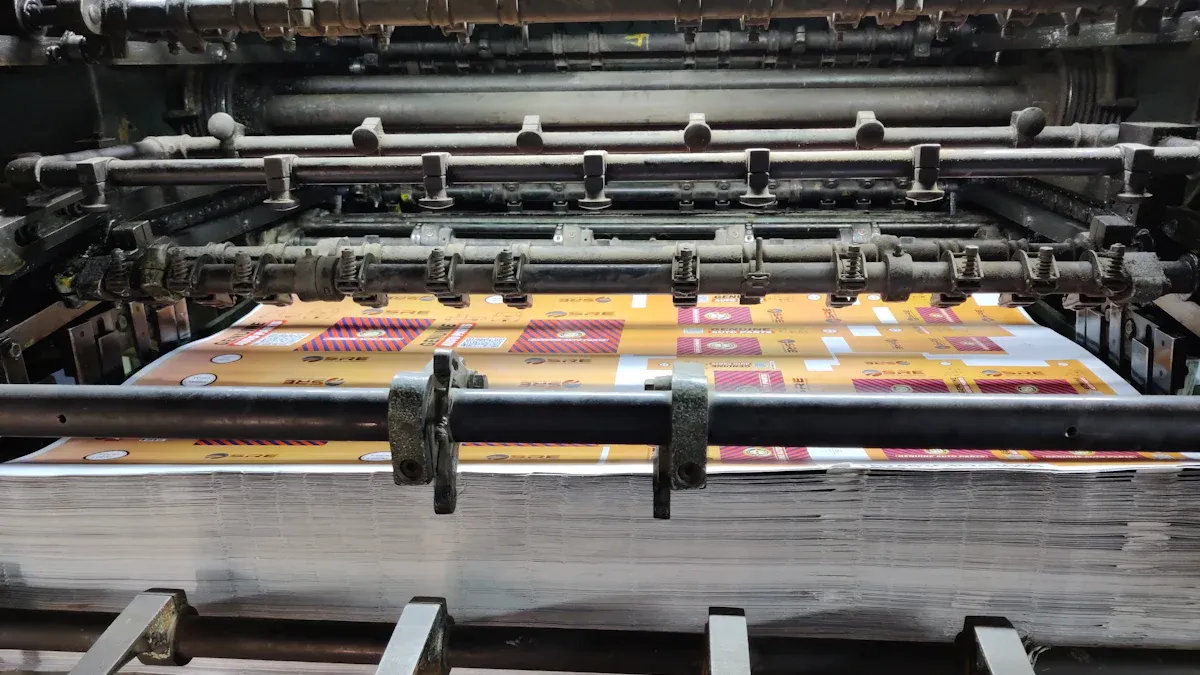Offset paper delivers exceptional print quality, making it a preferred choice for various industries. Its cost-effectiveness appeals to businesses, while its environmental benefits support sustainability efforts. Versatile and customizable, offset printing paper accommodates large-scale projects, meeting the diverse needs of sectors such as publishing, retail, and education. Additionally, uncoated woodfree offset printing paper is an excellent option for those seeking a more natural finish, while white cardboard in roll form provides a sturdy base for various applications.
Offset Paper and Superior Print Quality

Offset paper stands out for its superior print quality, making it a top choice for various printing needs. The print resolution of offset paper typically ranges from 300 to 2400 DPI, while digital printing usually falls between 150 to 300 DPI. This higher DPI in offset printing results in sharper and clearer images, which is crucial for professional applications.
Several factors contribute to the exceptional print quality of offset paper:
| Factor | Evidence |
|---|---|
| Coating | Coated papers limit ink absorption, resulting in sharper images and more vibrant colors. |
| Surface Texture | Studies show that smoother papers retain more ink on the surface, leading to glossier and sharper images. |
| Brightness | High brightness levels help colors appear more vivid and images look sharper. |
The coating on offset paper directly affects its print quality and durability. Smoother papers support better ink and water interaction, enhancing overall print quality. Brightness ratings above 90 are preferred for strong color contrast, ensuring clarity in printed graphics.
Moreover, offset paper is engineered for optimized ink absorption. This design prevents excessive bleeding or smudging, which can compromise print quality. The balance between ink absorption and surface retention allows for vibrant colors and sharp details. The smoothness of the paper plays a significant role; uncoated papers absorb more ink into their fibers, while coated papers retain ink on the surface, resulting in sharper prints.
In terms of durability, offset paper excels compared to other paper types. It is recognized for its longevity, making it suitable for various applications, including packaging materials. This durability is essential for products that require a longer lifespan, such as brochures and magazines. The production of offset paper adheres to ISO standards, ensuring it meets specific quality benchmarks, which further supports its performance.
Offset Paper Cost-Effectiveness
Offset paper offers significant cost advantages, especially for businesses engaged in large print runs. The initial setup costs associated with offset printing can be higher than those of digital printing. However, as the volume of prints increases, the cost per unit decreases, making offset printing more economical for larger projects.
Consider the following comparison of printing costs based on print run size:
| Print Run Size | Offset Printing Cost | Digital Printing Cost |
|---|---|---|
| Under 2,000 | More expensive | Most cost-effective |
| Over 2,000 | Most cost-effective | Less cost-effective |
For runs under 2,000 pieces, digital printing typically proves to be the most cost-effective option due to lower setup costs. However, once businesses exceed this threshold, offset printing becomes the more economical choice. The ability to spread the initial setup costs over a larger number of copies leads to substantial savings.
Additionally, businesses that print in bulk often benefit from reduced costs per unit. This reduction occurs because the initial setup expenses are amortized over a larger number of prints. Such savings become particularly significant for materials that do not require frequent updates.
When evaluating the overall costs associated with offset printing, it is essential to consider various operational expenses. The following table outlines typical maintenance and operational costs linked to offset printing presses:
| Cost Component | Description |
|---|---|
| Plates and Imaging Costs | Frequent plate replacements increase expenses. |
| Ink Consumption | Ink waste from improper settings or excess application can add up. |
| Paper Usage | Unnecessary waste during setup and printing leads to financial losses. |
| Energy Consumption | High power usage impacts operational budgets. |
| Maintenance and Repairs | Unexpected breakdowns can halt production and increase costs. |
By understanding these factors, businesses can make informed decisions about their printing processes. The long-term savings associated with offset paper can outweigh the initial costs, especially for high-volume projects.
Environmental Benefits of Offset Paper

In terms of energy consumption, offset printing generally requires more resources than digital printing. For instance, offset printing uses approximately 3.7 times more paper than digital printing for small print runs. Additionally, offset printing consumes about 16 grams of ink per impression, while digital printing only uses around 1 gram. Modern digital printing methods incorporate energy-saving principles, resulting in a smaller environmental footprint compared to offset processes.
Regulations also play a crucial role in shaping the offset paper industry. For example, the EU Industrial Emissions Directive drives manufacturers to adopt cleaner technologies. The EPA VOC Regulations compel manufacturers to shift towards chlorine-free bleaching and closed-loop water systems. These regulations encourage sustainable practices within the industry, ensuring that offset paper production aligns with environmental standards.
By choosing offset paper, businesses not only benefit from high-quality prints but also contribute to a more sustainable future.
Versatility and Customization of Offset Paper
Offset paper offers remarkable versatility and customization options, making it an ideal choice for various printing projects. Designers and marketers can leverage this flexibility to create unique print materials that stand out in a competitive market.
Offset printing accommodates a wide range of materials, including paper, metal, cardstock, and plastic. This capability allows for diverse applications, from packaging to promotional materials. Additionally, offset paper can handle different thicknesses and sizes, enhancing creative possibilities.
Customization options for offset paper include:
| Customization Option | Description |
|---|---|
| Embossing | Creates raised designs and text on the paper surface. |
| Metallic Ink | Uses reflective metallic particles for a shiny appearance. |
| Foil Stamping | Applies foil to paper using a heated die for a shimmering effect. |
| Die Cut | Allows for various shapes and contours to be cut from the paper. |
Moreover, popular finishes and textures available for offset paper enhance its appeal. Options such as gloss lamination, matte lamination, and soft-touch lamination provide different tactile experiences. Other techniques like spot UV and debossing add depth and visual interest to printed materials.
The adaptability of offset paper shines in large print runs. It excels in producing high-quality results for catalogs, newsletters, and presentation folders. While initial costs may be higher, the per-piece cost decreases significantly with larger quantities, making it a cost-effective solution for bulk jobs.
Offset paper stands out for its numerous advantages. It provides superior print quality, ensuring sharp images and vibrant colors. Businesses benefit from its cost-effectiveness, especially for large print runs. Additionally, offset paper supports sustainability through responsible sourcing. Its versatility allows for various customization options, making it an ideal choice for any printing project.
FAQ
What is offset paper?
Offset paper is a type of printing paper known for its high-quality print results and durability. It is ideal for large-scale printing projects.
How does offset printing differ from digital printing?
Offset printing uses plates to transfer ink onto paper, resulting in sharper images. Digital printing directly applies ink, which may lead to lower resolution.
Post time: Sep-26-2025
